Glass—Mill Scale—Plastics Wastes Upcycling for Synthesis of Ferrosilicon Alloy at 1550 °C: Implication for Zero Wastes Practice
Abstract
:1. Introduction
2. Materials and Methods
2.1. Materials
2.2. Experimental
3. Results and Discussion
3.1. The Produced Metal
3.2. Phase Analysis of the Produced Metals
3.3. Morphology of the Produced Metals
3.4. Formation of the Produced Metals
3.5. Possible Factors Affecting the Formation of Ferrosilicon Alloy
4. Conclusions
- The carbothermic reduction of glass–mill scale pellets (Blends A to F), using carbon derived from waste PS/PP (P1 to P6) as the reducing agent, can proceed at 1550 °C. The reaction produced numerous shiny metal droplets and a slag phase. The metallic yield for Blends A to F ranged from 16.65 wt% to 21.39 wt%, with Blends C to E showing notably high yields exceeding 20 wt%. The highest yield was observed in Blend D.
- XRD analysis revealed that the metal droplets consist of a ferrosilicon intermetallic compound, specifically the iron monosilicide (FeSi) phase, in all cases. The primary FeSi peak (110) was observed at a 2θ angle of approximately 45.03°, while the secondary peak (200) was observed at around 65.5°.
- SEM and EDS analysis revealed that the bulk metals primarily consist of Fe-Si-C, with no detected oxygen peaks. The highest Si concentration in the bulk metal was observed in Blend D, reaching 13.51 wt%. This was followed by concentrations of 11.76 wt% in Blend C and 8.46 wt% in Blend E.
- EDS elemental contour images confirmed that Si and C were distributed throughout the bulk metal alongside the Fe matrix. Particularly strong concentrations of Si were evident in Blends C through E, suggesting a more robust formation of the FeSi phase compared to the other blends.
- The maximum hardness of the produced metals, observed at 649.55 HV, was exhibited by Blend D, followed by Blends C and E with values of 500.5 HV and 479.84 HV, respectively. This trend reflects the higher silicon and carbon content in the alloy from Blend D, contributing to its increased hardness.
- In the system involving glass, mill scale, and carbon, the formation of FeSi can proceed directly through the diffusion/dissolution of solute Si atoms from the reaction zone into the liquid Fe matrix, facilitated by the interaction between SiC and liquid Fe. The mechanism steps for the formation of ferrosilicon alloy may be influenced by the rate of carbon dissolution into the liquid metal.
- In the present study, the optimal condition for producing ferrosilicon alloy using waste glass, mill scale, and plastics is achieved with Blend D, which uses a PS/PP mixture at a 70/30 weight ratio (P4) as the reducing agent. Waste PS/PP can completely replace fossil fuels as a reductant in this process. Higher purity of the final product can be obtained by using derived carbon as the reductant instead of fossil fuels.
Author Contributions
Funding
Data Availability Statement
Acknowledgments
Conflicts of Interest
References
- Okamoto, H. (Ed.) Desk Handbook Phase Diagrams for Binary Alloys, 2nd ed.; ASM International: Materials Park, OH, USA, 2010; p. 389. [Google Scholar]
- Gouttebroze, S.; Marthinsen, A.; Kroka, B.; Götz, A.; Ott, E. Modelling of major phases formation during solidification of Ferro Silicon-Magnesium. IOP Conf. Ser. Mater. Sci. Eng. 2023, 1281, 012052. [Google Scholar] [CrossRef]
- Gasik, M. Handbook of Ferroalloys Theory and Technology; Elsevier: Amsterdam, The Netherlands, 2013; pp. 3–4. ISBN 978-0-08-097753-9. [Google Scholar]
- Yoshisato, K.; Masashi, Y.; Yaw, W.C. Thermoelectric properties of nearly single-phase ꞵ-FeSi2 alloys fabricated by gas-atomized powder sintering. Mat. Trans. 2019, 60, 652–661. [Google Scholar]
- Kiatgamolchai, S.; Sakulkalavek, A. Distribution of elements in a Cu-Added FeSi2 alloy under peritectoid and eutectoid reactions. J. Electron. Mater. 2011, 40, 1029–1034. [Google Scholar] [CrossRef]
- Yamadaa, H.; Katsumata, H.; Yuasa, D.; Uekusa, S.; Ishiyama, M.; Souma, H.; Azumaya, I. Structural and electrical properties of ȕ-FeSi2 bulk materials for thermoelectric applications. Phys. Procedia 2012, 23, 13–16. [Google Scholar] [CrossRef]
- Cherigui, M.; Guessasma, S.; Fenineche, N.; Hamzaoui, R.; El-Kedimb, O.; Coddet, C. Studies of magnetic properties of iron-based coatings produced by a high-velocity oxy-fuel process. Mater. Chem. Phys. 2005, 92, 419–423. [Google Scholar] [CrossRef]
- Piamba, J.F.; Ortega, C.; Hernández-Bravo, R.; González Carmona, J.M.; Tabares, J.A.; Pérez Alcázar, G.A.; Alvarado-Orozco, J.M. Theoretical and experimental study of FeSi on magnetic and phase properties. Appl. Phys. A 2020, 126, 849. [Google Scholar] [CrossRef]
- Available online: https://www.grandviewresearch.com/industry-analysis/ferrosilicon-market# (accessed on 16 June 2024).
- Kopeć, G.; Przeliorz, R. Usefulness of Quartzites for the Production of Ferrosilicon. Solid State Phenom. 2015, 226, 111–114. [Google Scholar]
- Buo, T.V.; Gray, R.J.; Patalsky, R.M. Reactivity and petrography of cokes for ferrosilicon and silicon production. Int. J. Coal Geol. 2000, 43, 243–256. [Google Scholar]
- Available online: https://patents.google.com/patent/CN102517446A/en (accessed on 15 May 2024).
- Kongkarat, S.; Boonyaratchinda, M.; Chobtham, C. Formation of ferrosilicon alloy at 1550 °C via carbothermic reduction of SiO2 by coal and graphite: Implication for rice husk ash utilization. Solid State Phenom. 2021, 315, 16–24. [Google Scholar]
- Boonyaratchinda, M.; Kongkarat, S. Fundamental investigation of ferrosilicon production using rice husk and rubber tree bark at 1550 °C: Implication for utilization of agricultural waste in steelmaking industry. Mater. Sci. Forum. 2020, 977, 171–177. [Google Scholar]
- Farzana, R.; Rajarao, R.; Sahajwalla, V. Characteristics of waste automotive glasses as silica resource in ferrosilicon synthesis. Waste Manag. Res. 2016, 34, 113–121. [Google Scholar] [CrossRef] [PubMed]
- Farzanz, R.; Rajarao, R.; Sahajwalla, V. Synthesis of ferrosilicon alloy using waste glass and Plastic. Mat. Lett. 2014, 116, 101–103. [Google Scholar] [CrossRef]
- Ikram-Ul-Haq, M.; Mukherjee, P.S.; Khanna, R. Formation of light-weight ferroalloys in the Fe2O3-Al2O3-C system at 1550 °C: Influence of silica impurities. Metals 2017, 7, 391. [Google Scholar] [CrossRef]
- Chen, H.; Yu, W.; Jiang, W.; Jiang, W.; Wei, P.; Nyarko-Appiah, J.E. Fe-Si alloys production and alumina extraction from coal fly ash via the vacuum thermal reduction and alkaline leaching. Fuel Process. Technol. 2023, 224, 107702. [Google Scholar] [CrossRef]
- Wang, Y.; Zhang, Z.; Li, L.; Guo, Z.; Wei, D.; Kong, J.; Du, H.; Wang, H.; Zhuang, Y.; Xing, P. A novel process to recycle coal gasification fine slag by preparing Si-Fe-Al-Ca alloy. J. Environ. Manag. 2023, 337, 117681. [Google Scholar] [CrossRef] [PubMed]
- Hu, J.B.; Li, Y.B.; Wu, K.D.; Liu, F.; Zhu, Q.; Li, Y.W. The Exploration on Synthesis of Calcium Aluminate and Fe-Si Alloys Using Red Mud and Aluminum Dross. Adv. Mater. Res. 2010, 97, 1104–1108. [Google Scholar]
- Grudinsky, P.; Zinoveev, D.; Kondratiev, A.; Delitsyn, L.; Kulumbegov, R.; Lysenkov, A.; Kozlov, P.; Dyubanov, V. Reduction Smelting of the Waelz Slag from Electric Arc Furnace Dust Processing: An Experimental Study. Crystals 2023, 13, 318. [Google Scholar] [CrossRef]
- Shevko, V.M.; Aitkulov, D.K.; Badikova, A.D.; Tuleyev, M.A. Ferroalloy production from ferrosilicon manganese dusts. Complex Use Miner. Resour. 2024, 318, 43–50. [Google Scholar] [CrossRef]
- Etemadi, A.; Koohestani, H.; Tajally, M. The effect of different carbon reductants on the production of ferrosilicon 75% on an industrial scale in an electric arc furnace. Heliyon 2023, 9, e13956. [Google Scholar] [CrossRef]
- Nurpeisova, A.; Shevko, V.; Aitkulov, D.; Kushakova, L. Optimization of the electrothermal production of ferrosilicon from the leaching tailings of the oxidized copper ore of Almaly. Eng. J. Satbayev. Univ. 2023, 145, 19–24. [Google Scholar] [CrossRef]
- Grigorova, D. Ferrosilicon production method using sintered iron silicate—Fayalite. Metalurgija 2023, 62, 15–18. [Google Scholar]
- Blaesing, L.; Walnsch, A.; Hippmann, S.; Modrzynski, C.; Weidlich, C.; Pavón, S.; Bertau, M. Ferrosilicon Production from Silicon. Wafer Breakage and Red Mud. ACS Sustain. Resour. Manag. 2024, 1, 404–416. [Google Scholar] [CrossRef]
- Dankwah, J.R.; Koshy, P.; Saha-Chaudhury, N.; O’Kane, P.; Skidmore, C.; Knights, D.; Sahajwalla, V. Reduction of FeO in EAF steelmaking slag by metallurgical coke and waste plastics blends. ISIJ Int. 2011, 51, 498–507. [Google Scholar] [CrossRef]
- Dankwah, J.R.; Koshy, P.; O’Kane, P.; Sahajwalla, V. Reduction of FeO in EAF steelmaking slag by blends of metallurgical coke and end-of-life tyre. Steel Res. Int. 2012, 83, 766–774. [Google Scholar] [CrossRef]
- Sheshukov, O.; Mikheenkov, M.; Vedmid’, L.; Nekrasov, I.; Egiazaryan, D. Mechanism of Ion-Diffusion Solid-Phase Reduction of Iron Oxides of Technogenic Origin in the Presence of the Liquid Phase and without it. Metals 2020, 10, 1564. [Google Scholar] [CrossRef]
- Khanna, R.; Konyukhov, Y.V.; Ikram-ul-hag, M.; Burmistrov, I.; Cayumil, R.; Belov, V.A.; Rogachev, O.; Leybo, D.V.; Mukherjee, P.S. An innovative route for velarizing iron and aluminium oxide rich industrial wastes: Recovery of multiple metals. J. Environ. Manag. 2021, 295, 113035. [Google Scholar] [CrossRef]
- Liu, C.; Yuan, Y.; Jiang, J.T.; Gong, Y.X.; Zhen, L. Microwave absorption properties of FeSi flaky particles prepared via a ball-milling process. J. Magn. Magn. Mater. 2015, 395, 152–158. [Google Scholar] [CrossRef]
- Banerjee, P.; Kumar, N.S.; Franco, A.; Swain, A.K.; Naidu, K.C.D. Insights into the dielectric loss mechanism of bianisotropic FeSi/SiC composite materials. ACS Omega. 2020, 5, 25968–25972. [Google Scholar] [CrossRef]
- Available online: https://dataintelo.com/report/global-fesi15-market/ (accessed on 15 May 2024).
- Rahman, M.; Khanna, R.; Sahajwalla, V.; O’Kane, P. The Influence of Ash Impurities on Interfacial Reactions between Carbonaceous Materials and EAF Slag at 1550 °C. ISIJ Int. 2009, 49, 329–336. [Google Scholar] [CrossRef]
- Singsai, S.; Kongkarat, S. Utilization of polymeric wastes in steel refining process: Carbon Dissolution into liquid steel at high temperature. Heliyon. 2023, 9, E13328. [Google Scholar] [CrossRef]

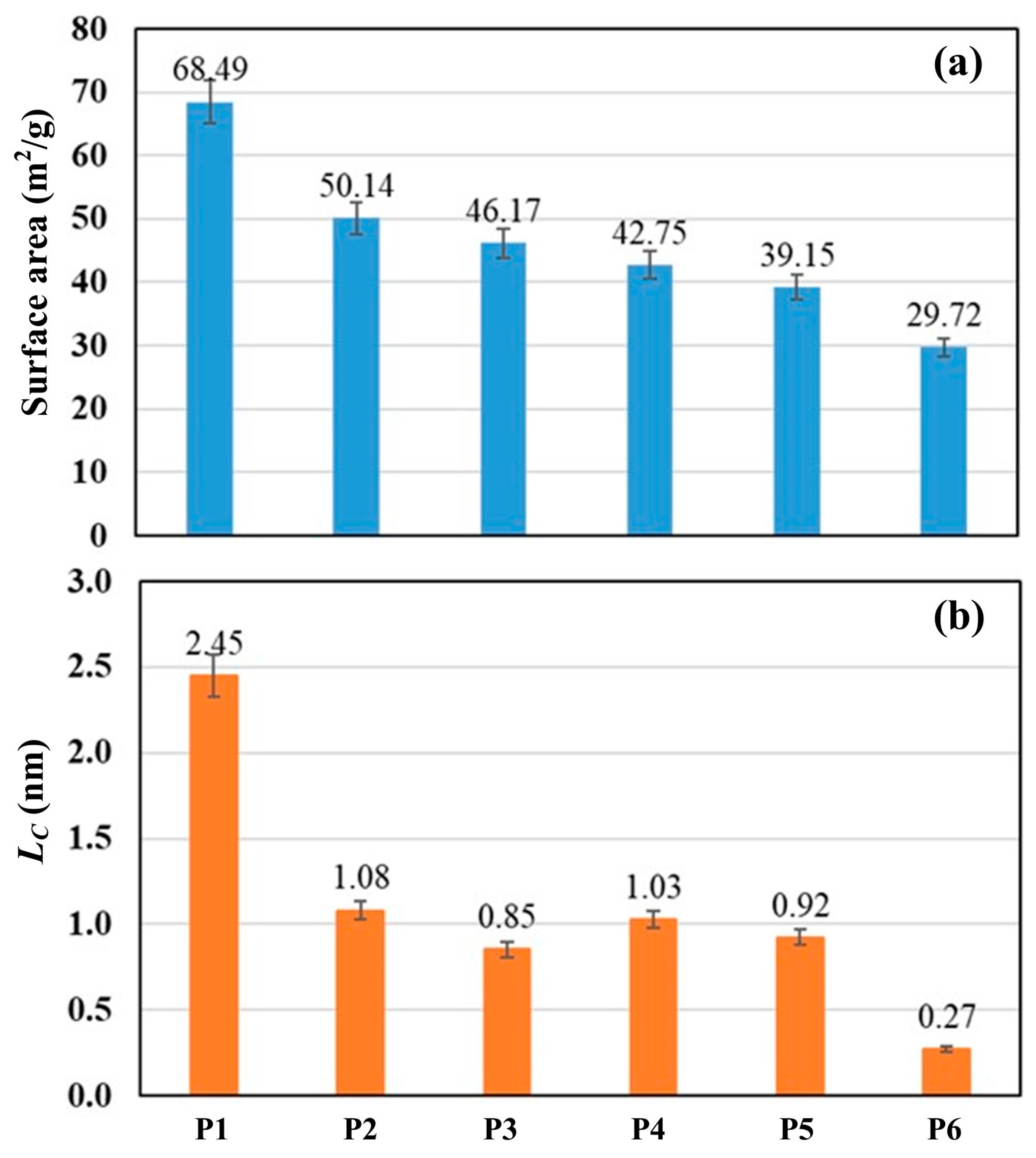
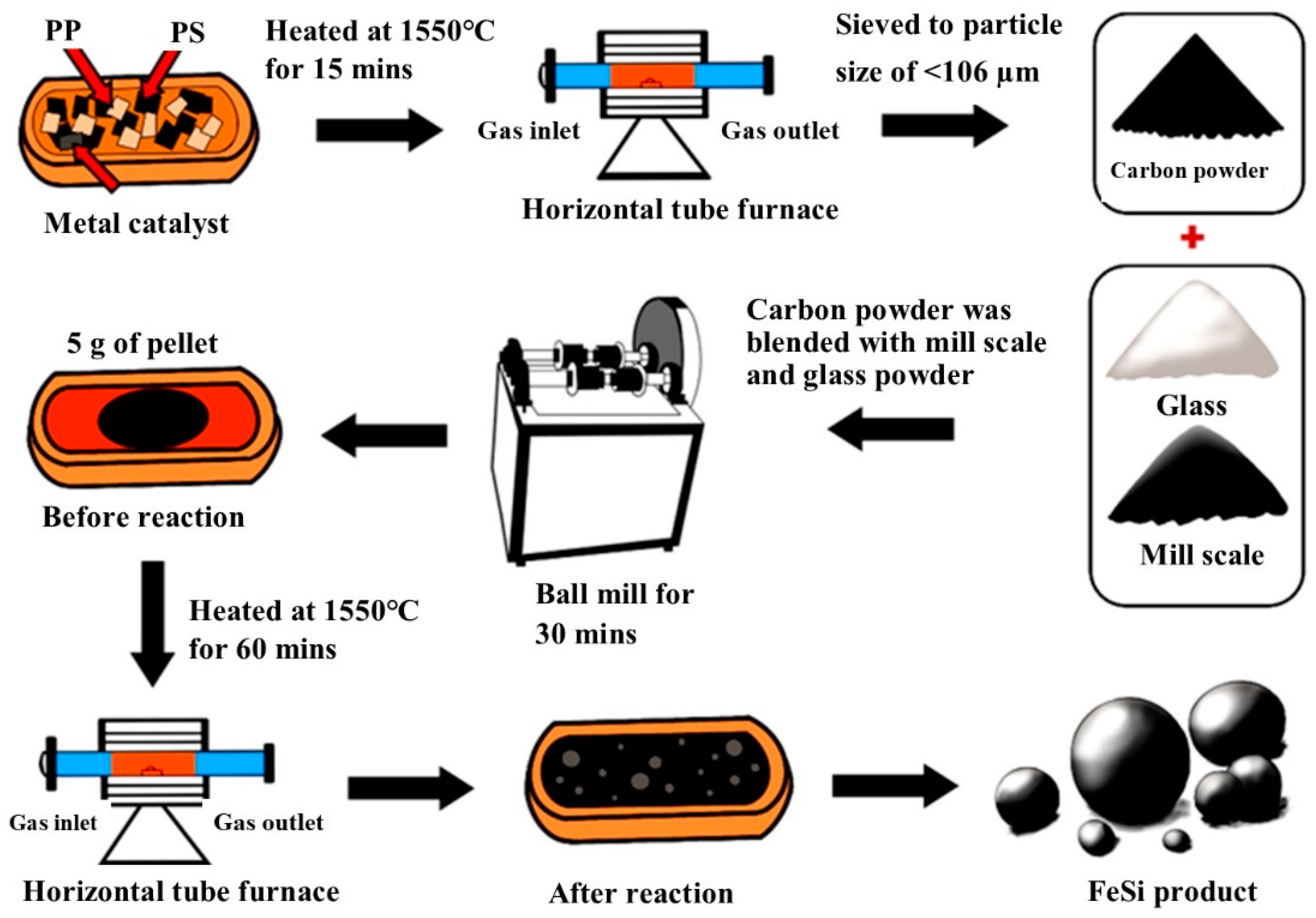
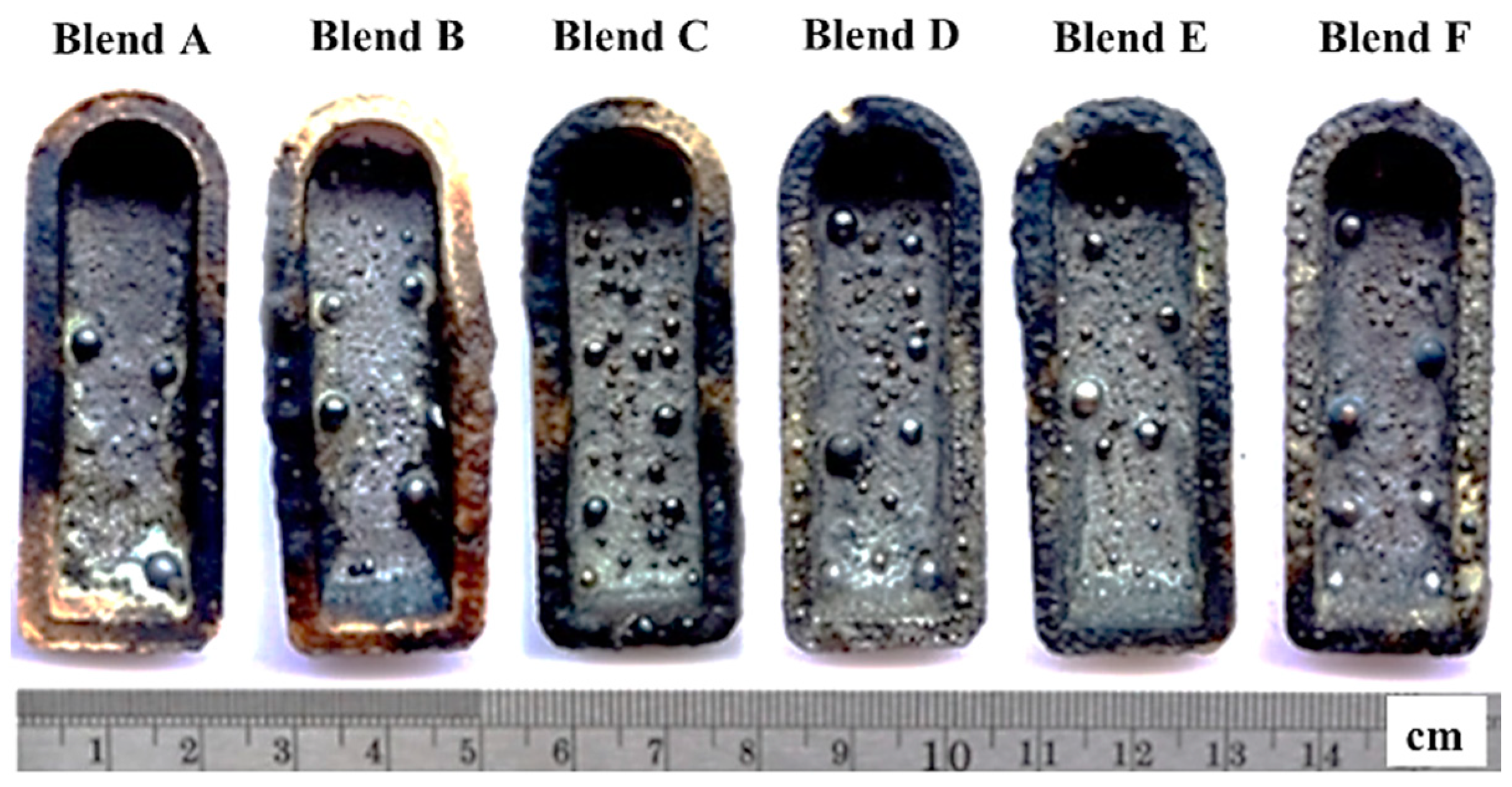

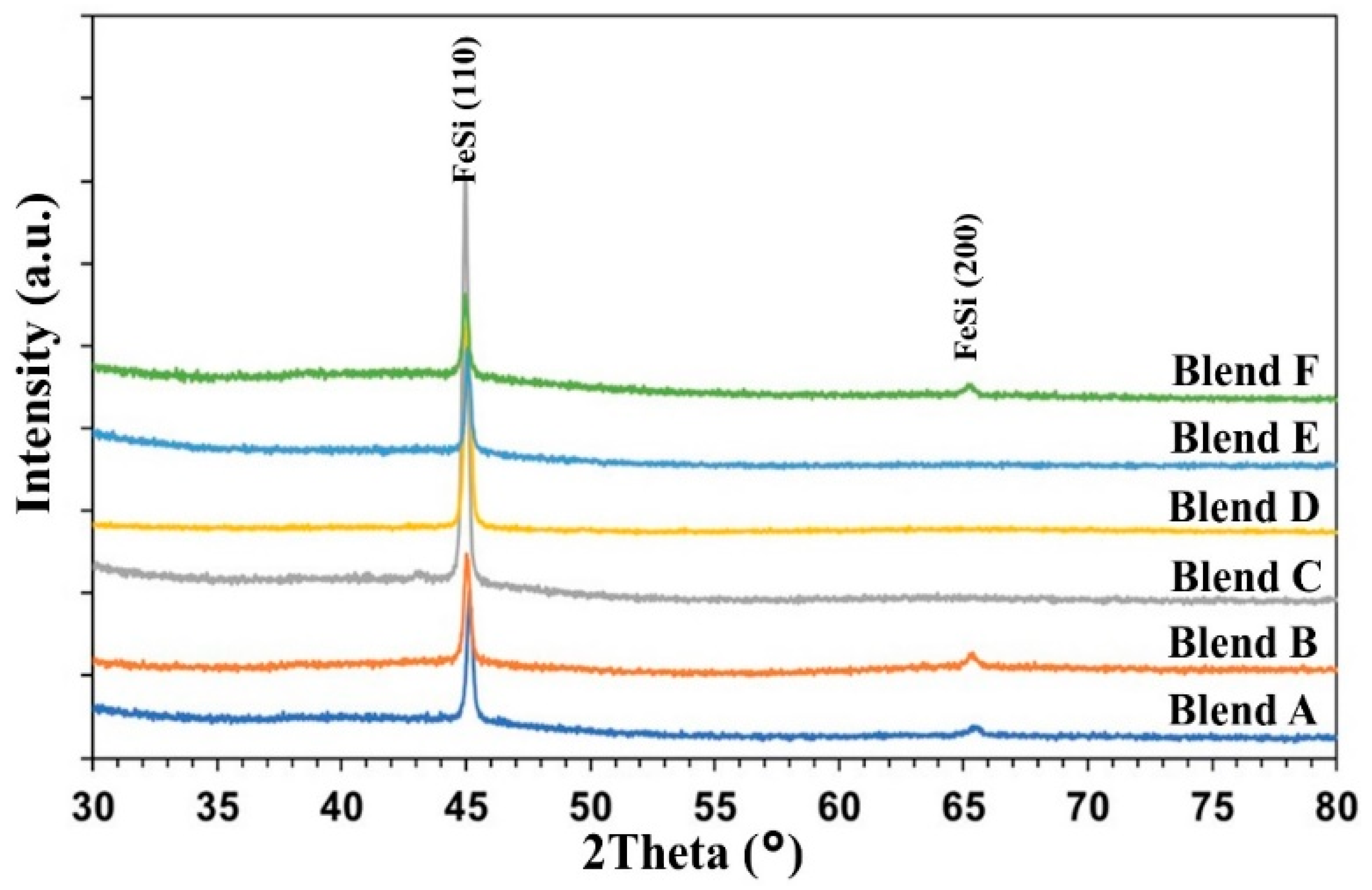

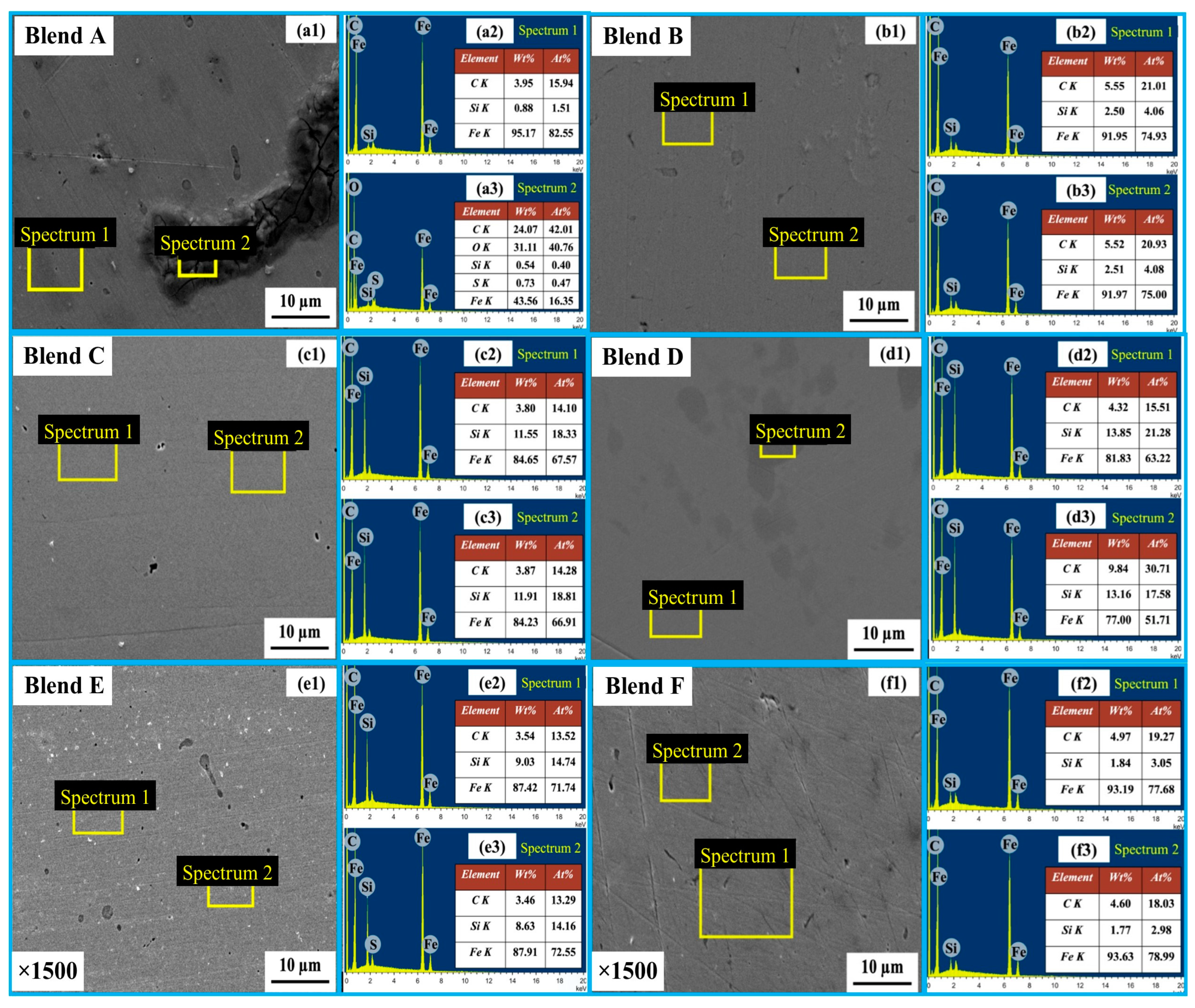
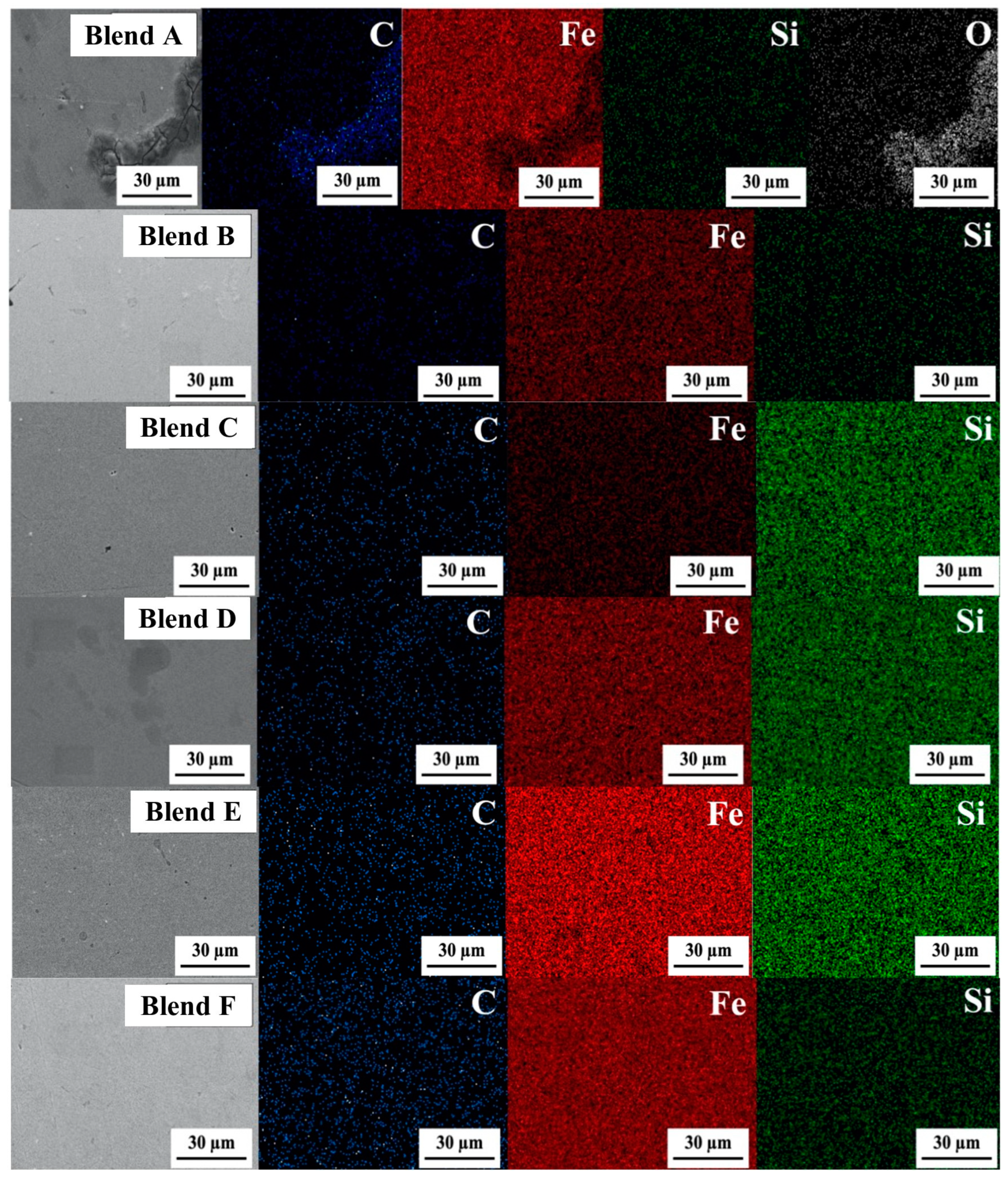


| Samples | Chemical Composition (wt%) | |||||||||
|---|---|---|---|---|---|---|---|---|---|---|
| SiO2 | Fe2O3 | Al2O3 | Na2O | CaO | SO3 | MgO | K2O | TiO2 | P2O5 | |
| Glass | 73.56 | 0.29 | 1.41 | 13.01 | 8.08 | 0.27 | 3.27 | 0.07 | - | - |
| Scale | 1.42 | 93.66 | 0.82 | - | 0.17 | 0.08 | - | 0.02 | 0.04 | 0.04 |
| Derived Carbons | Plastics Mixed | Chemical Composition (wt%) | ||||
|---|---|---|---|---|---|---|
| PS (wt%) | PP (wt%) | C | H | N | S | |
| P1 | 100 | 0 | 87.77 | 0.23 | 0.27 | 0.42 |
| P2 | 90 | 10 | 86.04 | 0.57 | 0.38 | 0.46 |
| P3 | 80 | 20 | 87.65 | 0.53 | 0.27 | 0.44 |
| P4 | 70 | 30 | 85.97 | 0.72 | 0.23 | 0.42 |
| P5 | 60 | 40 | 89.23 | 0.55 | 0.30 | 0.43 |
| P6 | 50 | 50 | 90.57 | 0.64 | 0.30 | 0.46 |
| Glass—Scale—Carbon Blends | Pellets Components (wt%) | |||
|---|---|---|---|---|
| Glass | Scale | Carbon | Total | |
| A (Glass/Scale/P1) | 34.36 | 39.78 | 25.86 | 100 |
| B (Glass/Scale/P2) | 34.15 | 39.62 | 26.24 | 100 |
| C (Glass/Scale/P3) | 34.35 | 39.77 | 25.88 | 100 |
| D (Glass/Scale/P4) | 34.14 | 39.61 | 26.25 | 100 |
| E (Glass/Scale/P5) | 34.54 | 39.91 | 25.55 | 100 |
| F (Glass/Scale/P6) | 34.70 | 40.03 | 25.27 | 100 |
| Blends Pellets | Raw Pellets (g) | Heated Pellets (g) | Slag (g) | Produced Metal (g) | Slag Yield (%) | Metallic Yield (%) |
|---|---|---|---|---|---|---|
| A | 5.02 | 2.098 | 1.262 | 0.836 | 25.15 | 16.65 |
| B | 5.01 | 2.192 | 1.308 | 0.884 | 26.11 | 17.64 |
| C | 5.03 | 2.600 | 1.556 | 1.044 | 30.93 | 20.76 |
| D | 5.02 | 2.706 | 1.632 | 1.074 | 32.52 | 21.39 |
| E | 5.03 | 2.547 | 1.524 | 1.023 | 30.30 | 20.34 |
| F | 5.01 | 2.328 | 1.408 | 0.920 | 28.10 | 18.35 |
Disclaimer/Publisher’s Note: The statements, opinions and data contained in all publications are solely those of the individual author(s) and contributor(s) and not of MDPI and/or the editor(s). MDPI and/or the editor(s) disclaim responsibility for any injury to people or property resulting from any ideas, methods, instructions or products referred to in the content. |
© 2024 by the authors. Licensee MDPI, Basel, Switzerland. This article is an open access article distributed under the terms and conditions of the Creative Commons Attribution (CC BY) license (https://creativecommons.org/licenses/by/4.0/).
Share and Cite
Kongkarat, S.; Amnuanpol, S.; Wongsawan, P. Glass—Mill Scale—Plastics Wastes Upcycling for Synthesis of Ferrosilicon Alloy at 1550 °C: Implication for Zero Wastes Practice. Metals 2024, 14, 784. https://doi.org/10.3390/met14070784
Kongkarat S, Amnuanpol S, Wongsawan P. Glass—Mill Scale—Plastics Wastes Upcycling for Synthesis of Ferrosilicon Alloy at 1550 °C: Implication for Zero Wastes Practice. Metals. 2024; 14(7):784. https://doi.org/10.3390/met14070784
Chicago/Turabian StyleKongkarat, Somyote, Sitichoke Amnuanpol, and Praphaphan Wongsawan. 2024. "Glass—Mill Scale—Plastics Wastes Upcycling for Synthesis of Ferrosilicon Alloy at 1550 °C: Implication for Zero Wastes Practice" Metals 14, no. 7: 784. https://doi.org/10.3390/met14070784
APA StyleKongkarat, S., Amnuanpol, S., & Wongsawan, P. (2024). Glass—Mill Scale—Plastics Wastes Upcycling for Synthesis of Ferrosilicon Alloy at 1550 °C: Implication for Zero Wastes Practice. Metals, 14(7), 784. https://doi.org/10.3390/met14070784






